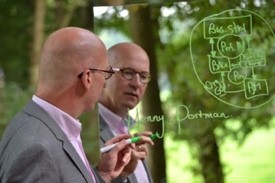Sensemaking in the Agile Forest
SERIES ARTICLE
By Henny Portman
The Netherlands
Introduction[1]
Kanban is originally a system from the manufacturing industry to reduce inventory and deliver exactly on time (just in time, or JIT). It was developed by Japanese Taiichi Ohno at car manufacturer Toyota (first version in 1953). This system keeps production process overloads in check by working with upper limits for the number of pieces of work in progress.
Kanban method
Based on Taiicho Ohno’s Kanban system, a Kanban method has been developed to support knowledge workers. One of the first to write about it was David J. Anderson on its application in software development. Today, we see more and more disciplines using Kanban systems to manage their work, such as marketing, product development, human resources, legal, auditing, et cetera. However, many implementations go no deeper than a board and the visualization of work in progress. Few reach the depths that are behind Kanban, including measuring numbers and lead times and actively managing work in progress.
The Kanban philosophy
Kanban literally means ‘signal card’ in Japanese. The main features of a Kanban system are:
- The process to be managed is divided into several different steps.
- The workflow is visualized.
- Work in progress is limited.
- Lead times are controlled and measured.
- Performance agreements, such as the number of units of work in progress or lead times, are recorded.
- Feedback loops are frequently used (with the team and with the customer/client).
- The workflow can be subdivided by service classes (incidents, maintenance, projects).
- The team makes joint agreements on how the work is managed.
- The team improves the way of working together.
The Kanban system
Introducing Kanban is an evolutionary process. Start by focusing on quality. Then reduce the work in progress. Having too much work in progress in the system means frequent multitasking. To implement a Kanban system, the following steps can be followed (see example):
- Determine the start and end point of the process, including the intermediate steps, and record this work process on a visual board so that the status of work in progress and where a specific work unit is located can be seen immediately.
- Add queues and buffers to control the flow in the process.
- Define the design of signal cards. Define what information will be recorded on them (ID number, name, description, recording date, any hard completion date, etc.).
- Define the boundaries at the beginning and at the end of the process. Include a corresponding queue at the start and end and define how and when prioritization of the input queue takes place and how products are transferred to the receiving party.
More…
To read entire article, click here
Editor’s note: This is the 11th article in a series by Henny Portman, one of the world’s leading authorities on “agile”. Based in The Netherlands, Henny coined the term “agile forest” in 2019 to describe the many agile frameworks that have emerged over the last 20 years. This series is intended to help readers better understand the agile concept, navigate through the ‘underbrush’ and more successfully apply whichever framework is selected for their projects.
How to cite this article: Portman, H. (2023). Kanban in a nutshell, Sensemaking in the Agile Forest series, PM World Journal, Vol. XII, Issue IV, April. Available online at https://pmworldjournal.com/wp-content/uploads/2023/04/pmwj128-Apr2023-Portman-Kanban-in-a-nutshell-agile-forest-series-16.pdf
About the Author

Henny Portman
The Netherlands
![]()
Henny Portman, owner of Portman PM[O] Consultancy and was partner of HWP Consulting, has 40 years of experience in the project management domain. He was the project management office (PMO) thought leader within NN Group and responsible for the introduction and application of the PMO methodologies (portfolio, program, and project management) across Europe and Asia. He trains, coaches, and directs (senior) programme, project and portfolio managers and project sponsors at all levels, and has built several professional (PM(O)) communities.
Henny Portman is accredited in a variety of qualifications, including P3O, PRINCE2, MSP, MoP, PRINCE2 Agile, AgilePM, AgilePgM and AgileSHIFT trainer and an SPC4 SAFe consultant and trainer. He is a P3M3 trainer and assessor and PMO Value Ring Certified Consultant (PMO Global Alliance). On behalf of IPMA, he assesses mega and large projects for the IPMA Project Excellence Award. In addition to this, he is an international speaker, author of many articles and books in the PM(O) field, and an active blogger. More at hennyportman.wordpress.com
Henny can be contacted at henny.portman@gmail.com
To view other works by Henny Portman, visit his author showcase in the PM World Library at https://pmworldlibrary.net/authors/henny-portman/
[1] This article is based on a paragraph of my Dutch book Scaling agile in organisations









